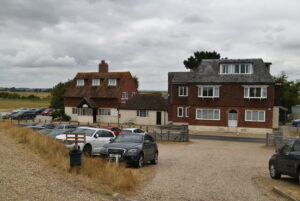Lovers of the Tilling novels of EF Benson will be aware of the way in which Major Benjy and his deceased friend and partner in the late night’s deception of Elizabeth Mapp, Captain Puffin, made their way out to the golf links. Invariably they would take the tram – apart from the time that Susan Wyse lent them the Royce. The alternative was a taxi, but that was ruinously expensive, as the Reverend Bartlett found, when it was thought that the Major and Captain were fighting a duel in the sand dunes near the club. It was so much that he even considered charging the expense, half a crown, to church funds. In the end he paid from his own pocket. Half a crown then is now about £9.
The line was opened with the express intention of transporting golfers to the new Rye Golf Club, which was formed as the result of a meeting on November 28 1893, with the first competition happening in February 1894. The line was the brainchild of Colonel Holman F Stephens, and was built exclusively on private leasehold land between January and July 1895. Being entirely on private land meant that no government approvals were needed. It formally opened on July 13, two days after its carriage and locomotive had arrived. It was unusual in its particularly narrow gauge, only three feet. Just under two miles long, it ran from Monk Bretton Bridge in Rye to the club. Thirteen years later, in 1908, it was extended to Camber Sands, to cater for the increasing number of holidaymakers. It was also useful to members of the fishing community.
Such was its value to the golf club and, apparently, other Rye-based clubs, that those clubs paid a subsidy to the line to keep it open in winter, when, with fewer holidaymakers, it would otherwise not be profitable to keep the line open. Changing times meant that from the early years of the 1920s, more and more golfers had their own cars, so use of the tram by golfers declined steeply. For those less affluent there was a regular bus service that served the golf club and Camber Sands. The club subsidy was paid for the last time in 1925, so from the following year the line only operated during the more profitable summer months.

The line had been worked with two steam trains, Camber and Victoria and two fully enclosed carriages, one of which had been built locally, by the Rother Iron Works, based in Rye. For clement weather transport there were two open wagons with seats, rather like the original third class carriages on the early railway networks like the Stockton and Darlington company. The tram also offered a service to local builders, whereby sand could be carried up to the town in a number of open wagons. The remains of one of the carriages can be seen in the Colonel Stephens Museum by Tenterden station, which has an interesting display about the tram line.
The Camber Sands station was moved to a better site and, at the end of the 1938 summer season a hut for serving tea was built there. Their use was short-lived. The Second World War was announced on September 3 1939, effectively ending the summer season. The last fare paying passengers travelled on the line on September 4. On December 12 the Royal Navy took the line over, using it when improving Rye Harbour. It was also used to carry parts for PLUTO, the pipeline under the ocean, first suggested by Lord Mountbatten in 1942, as a way of reducing the amount of fuel that had to be transported by ship to the Normandy beaches to support Operation Overlord. Canadian troops built a new pier at Golf Links station to support the project.
Sadly, its wartime use left the tram system in such poor condition that it was impossible to revive it, and it was sold as scrap in 1947, with its company being finally liquidated in February 1949. The golf club station is still there and some track, but most of its original route is now a footpath.
Why, you might ask, is there a mention of a beanfeast in the title? Simple. One of the early adverts for the tram said that, “Camber is an ideal spot for picnics, beanfeasts and school treats.”
Image Credits: John Minter , N Chadwick CC .




Rye Golf Club have introduced security gates on the road access to the Golf Club station. The pin code for entry is not available to the general public. At present the road is closed from around 0800 to 1700 hrs (its closure times are purely at the behest of the Golf Club). The Environment Agency have closed the river bank access for at least the next two years whilst flood defence work is ongoing. The easiest way to access the station at present, is to alight from the Camber bus service at the Golf Club stop and cross the golf course via the public right of way which exits right next the station. This right of way needs to be used or it may well result in a use it, or loose it situation. Other than that, pedestrians can walk the Camber Sands foreshore along to the Harbour entrance and follow the river up to the station.